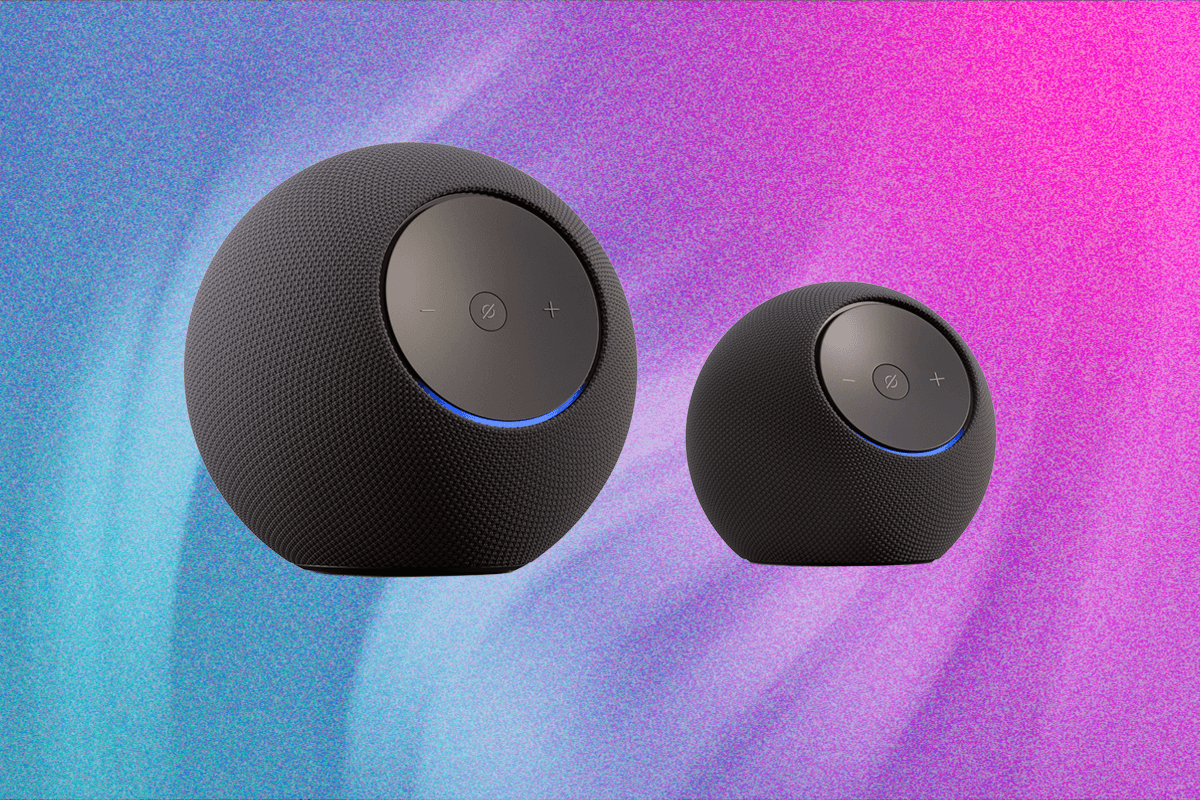Amazon’s speakers have a new look—and new leaders—with the newest lineup of the brand’s Echo devices. Amazon’s fall hardware event in September announced the next frontier of the Alexa-powered speakers, but strangely enough, none of them was a fifth-generation Echo. Instead, Amazon has leaned in to two specific speakers: the Echo Dot, now named the Echo Dot Max and costing what the main, full-size Echo used to, and the immersive speaker powerhouse that is the Echo Studio, now in its second generation.
Perhaps Amazon is finally planning on cutting down its lineup to focus on the best of the best. We’ve long recommended the Echo Dot and Echo Studio as some of the best of Amazon’s overcrowded Echo lineup, and no other smart speaker maker offers as many options. Several Echo models have also had limited to zero availability this year, including the screen-equipped Echo Show 10 (which the new-generation Echo Show 8 and 11, due out in November, seem primed to replace) and the once-flagship Echo. There’s still a wide range, though, and perhaps Amazon’s new strategy is to cash in on the popular Echo Dot model’s getting a higher price tag, and letting speakers like the Echo Pop take the role of the cheap option.
Will it pay off? Will Amazon’s lineup finally become a little more focused? We’ll have to wait and see. For now, it’s safe to say that the new Echo Dot Max and 2nd Gen Echo Studio are both fantastic in sound performance and at doing what a smart speaker does best: answering questions, especially with Amazon’s newest assistant, Alexa+, included right out of the box. But they cost much more than the flagship Echo and Echo Dot used to.
Fresh Profile

The Amazon Echo Studio (2nd Gen) and Amazon Echo Dot Max.
Photograph: Nena Farrell
The Echo speakers have a new design with these two models: a circular body with an indented center, reminiscent of a speaker dust cap. In that indent is now where you’ll find the volume buttons and mute button. On the top there’s now a touch control, which you can tap to instantly pause or resume music. (There are options in the app to turn the touch controls off if they’re not up your alley.) The light-up ring that tells you when Alexa is listening is now around that indent, and both models have a smart home hub built into them, which the Studio previously had but older Echo Dots did not.
I like the new design. The volume buttons feel large and flat and are more comfortable to click than the smaller ones that were on top of the previous Echo Dots and main Echo. My only complaint is that the matte plastic gets a skin-oil sheen on the buttons after a few touches. But other than a new drive to keep these new Echos clean, the design feels like a nice update and is easy to use. It’s also much easier to see what button you’re hitting, since you no longer need a top-down view to be sure you’ve reached for the right button. (Perhaps this is more of a short person’s problem than tall folks, but it could also depend on where you keep your speaker.)
The cover is also different than past models, and feels very different to the touch. Both Echos use a 3D knit fabric, which has much more texture than the previous cover design. It looks more textured, too, with an almost scaly look to it. However, unless you’re using the tap controls a lot, you won’t be touching the cover as much as the previous Echo designs.
Sound Sphere

The Apple HomePod (2nd Gen) and Amazon Echo Studio (2nd Gen).
Photograph: Nena Farrell
The new 2nd Gen Echo Studio has three 1.5-inch drivers, plus a 3.75-inch woofer to power the sound. It has rich sound, nailing everything from the soft tones of Tracy Chapman’s Fast Car to the piano riffs of Dark Blue by Jack’s Mannequin, and it’s almost insanely loud. I have a long, great room that runs from the living room to the kitchen and finally to the dining room, and I didn’t need the Echo Studio on its highest setting to enjoy music on the opposite side of the room. I think most homes will never need the amount of volume the Studio can pack, but it’s great for audiophiles or folks who love to throw a big party and need a speaker that can blast sound throughout it. It’s also surprisingly compact for the amount of volume it gets. Side by side with its closest smart speaker competition, the Apple HomePod, it’s smaller and cheaper, but the sound it packs makes it worth choosing instead.
Meanwhile, the Echo Dot Max just has one 0.8-inch tweeter and a 2.75-inch woofer, but the sound quality wasn’t intensely different. The bass didn’t have as much depth, and the duet voices of Ariana Grande and Cynthia Erivo in What Is This Feeling? sounded slightly muddled compared to the Echo Studio. But that’s with side-by-side testing. I think anyone with just the Echo Dot Max would be impressed with the sound quality on this pint-sized speaker, and it filled my great room on a level I didn’t expect.
Both speakers have automatic room adaptation to adjust the sound for room boundaries. The Echo Studio also has spatial audio capabilities, including Dolby Atmos and Sony 360 Reality. Both speakers have four microphones each, and did a pretty good job responding to my voice commands from across the room. They were also usually pretty good at hearing me while music was playing. If you’re in a larger room like I was, you might have to project your voice a little more, but I never needed to shout.
New Kid Included

The Amazon Echo Spot (2nd Gen) and Amazon Echo Dot Max.
Photograph: Nena Farrell
Both of these speakers have new silicon chips, the AZ3 for the Dot Max and AZ3 Pro for the Studio, to support the audio capabilities and Amazon’s new assistant, Alexa+. Both of these speakers will have early access Alexa+ right out of the box, so there’s no waiting list needed to start using it. The waiting list prioritizes accounts with Echo Show devices right now, so folks without one might still be sitting around waiting. Getting one of these speakers will jump you to the front of the line.
I didn’t see a huge difference in Alexa+ performance with the new chips versus older ones. I tested the Echo Spot with Alexa+ side by side with the new Echo Dot Max and Studio, and the Spot responded to questions just as quickly and with the same details as the two speakers with newer chips. Both did a good job of quickly answering questions—from telling me about my calendar to giving me day-trip suggestions based on where I live—and took a similar amount of time to process and provide an answer.
The Echo Spot did come out last fall, though, so its processor is newer than, say, an Echo from the 2010s. But even so, I don’t think Amazon designed Alexa+ to force you to upgrade your speaker; the intention is to get existing users to sign up for Amazon Prime or pay the $20-a-month fee Alexa+ will charge once it’s out of early access for non-Prime users.
Price Tag

Photograph: Nena Farrell
While the Alexa+ inclusion is great, you don’t need to buy these speakers to get it. It’ll come your way eventually, and your existing speakers (if you have an Echo already, that is) can probably do the job just as well. You also don’t need a replacement if you already have a recent Echo Dot—particularly the 5th Gen, which had better bass than past models, though it’s not as good as the new Dot Max or the Echo Studio.
It’s important to note that while the new 2nd Gen Echo Studio is technically the same price ($220) as its previous model, it’s essentially replacing the 4th Gen original Echo, which only cost $100. Or maybe the Echo Dot Max is the one replacing the primary Echo, since it now has the $100 price tag? Who can be sure? Amazon clearly isn’t, which is why neither of these is labeled as 5th Gen, and instead the Dot gets a new, longer name.
The sound quality does make the price tag worth it to some extent. The $100 price tag for the surprisingly loud Echo Dot Max is a good price for everything you’re getting, now that its sound is further improved and now packs a smart home hub, but feels a little silly for a speaker so small that was once so cheap—past iterations of the Echo Dot were only $50.
Ultimately, you don’t need either of these speakers, especially if you have the previous models. But if you were already in the market for a new smart speaker, these are the two smartest ones to buy for the sound quality and chip power that should last you for years to come.




